Announcements
Welcome to Care of Magical Creatures 601!
I'd like to give you a warm welcome to the Care of Magical Creatures classroom! If you have any questions about the class, please feel free to reach out to Professor Montclam by owl or visit her newly refurbished office!
Note: During the transfer period of professors, you may find some inconsistencies among the lessons. I appreciate your cooperation during this time!
Lesson 4) Serpentine Fire
Come in, come in! Today we have a longer lesson, with quite a bit of information. Both Professor Cattercorn and I will attempt to keep it to the most important information, but these two birds are incredibly interesting, so excuse us if we run a little long. A friendly reminder that your midterm is next class, so make sure to start studying. Now, with that little bit out of the way, please enjoy Professor Cattercorn’s discussion about the Occamy!
The Occamy: The Shrinking Beaked Serpent
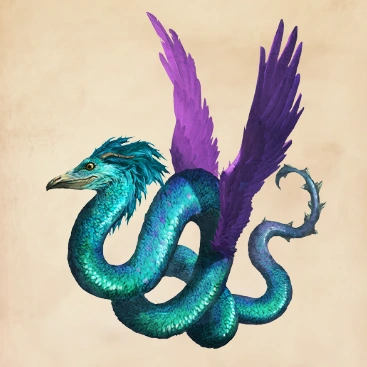 Thank you for those opening remarks, Professor Anne. So now students, let us go ahead and get started with the creatures of this lesson! Today we’re going to begin with a curious creature known as the Occamy.
Thank you for those opening remarks, Professor Anne. So now students, let us go ahead and get started with the creatures of this lesson! Today we’re going to begin with a curious creature known as the Occamy.
At first sight, you will note that Occamies are beautiful, serpentine beasts with wings. They are commonly found in the Far East and India. According to the Ministry of Magic, Occamies are classified as beasts and they have a rating of XXXX, as they can be highly dangerous. Some of you may take interest in the fact that one can produce an Occamy as their Patronus. This is rather rare, however.
Appearance and Behavior

As you can see, Occamies are very beautiful to the human eye, though some might say they’re rather intimidating. They can be quite massive, for example, they can grow up to 15 feet long (about 4.7 meters). With a snake-like body and wings, these beasts can either slither or fly, making for quite an interesting characteristic. Their whole bodies are feathered, and they have impressive plumes on their heads.
As for being intimidating, Occamies (especially the adults) can be rather aggressive to anyone who gets near them. This is where they get their XXXX rating. They are extremely protective over their eggs, so harvesting these, or even being a caretaker for one of these beasts is a very dangerous job. Young Occamies are a bit more accepting of humans, though an adult Occamy would only be tolerant of a caretaker that they knew very well.
Occamies are what we call choranaptyxic. This means that this creature has the ability to adapt in size to fit the space it occupies. It does have a 15 foot limit as we learned previously, so keep that in mind. Adding on to that fact, Occamies can grow legs and bird-like feet according to the situation or if they need them. For example, these feet can make for much smoother lands after a flying session, or they can be used to help catch prey while in the air.
Some people have said that Occamies bear a resemblance to the Quetzalcoatl. Quetzalcoatl is a feathered serpent, commonly recognized as the god of intelligence and self-reflection in Central American mythology.

Diet
 Occamies are primarily carnivores. They are known to prey on small rodents such as mice and rats when they are slithering on the ground. They will also hunt birds when they are in the air, and hunt monkeys on occasion. They will settle for insects in a pinch, though they are not necessarily an Occamy’s favorite thing to eat.
Occamies are primarily carnivores. They are known to prey on small rodents such as mice and rats when they are slithering on the ground. They will also hunt birds when they are in the air, and hunt monkeys on occasion. They will settle for insects in a pinch, though they are not necessarily an Occamy’s favorite thing to eat.
Reproduction
Occamies reproduce in a similar way to mundane snakes. However, they have some bird-like habits as well, but we’ll get into that in a moment. Occamy reproduction can occur at any time of the year, though it is more common during the spring, as this is when the weather is getting warmer. It is important to note that male Occamies will be much more aggressive during any time they are looking for a mate. They have definitely been known to fight with each other over female Occamies.
When a male is interested in a female, he will attempt to win her affection by crawling on top of her and tapping his head on the back of hers. If she accepts his offer, she will raise her tail. The male will then wrap his tail around the female’s so that their cloacas come together. A cloaca is a cavity that stores the digestive, excretory, and reproductive organs on the underside of the animal. The male Occamy will then insert his sex organs (known as the hemipenes) into the female’s cloaca. They will mate for at least 45 minutes, but some mating sessions have taken as long as 24 hours.
As you already know, Occamies lay eggs. So once a male and female Occamy have mated, the female will begin to lay her eggs. She will try to find a safe spot for her nest; many of them prefer to burrow into the ground. For their nest, an Occamy will lay anywhere from three to six eggs, and they will have offspring every six months at most. That is a maximum of 12 offspring a year! Like a bird, Occamies will sit on their eggs for about 36 days in order to make sure the babies develop properly.
Once the nest has hatched, the mother will stay around to protect the young. The young Occamies look just the same as the adults, just smaller. Newborns can be anywhere from one to two feet long (30.5-61cm). They will be able to live on their own at just a few months old, however they won’t reach sexual maturity until they are about five years of age.
The eggshells of Occamies are rather valuable themselves. They are made of pure, soft silver. It’s a little known fact that they are used as currency in some countries, even gifted to individuals to show respect. Occamy eggs have their own special uses in the magical world. One of the more well-known and common uses for them is in potion making. For example, you cannot make Felix Felicis without Occamy eggshells. They are made of silver, but substituting the shells for actual silver would not have the same effect, since authentic silver has much different magical qualities.
I will now pass the lesson over to Professor Anne to discuss the phoenix!
The Snallygaster: An Ever Curious Reptilian Bird
Before I move on to discussing the phoenix, I would like to take a moment to discuss a distant relative of the Occamy: the Snallygaster! This bird-reptile creature is well-known as a cryptid in the Muggle world. However, in the wizarding world, it is known as one of the most curious creatures and cause for breeches in the International Statute of Wizarding Secrecy.
They are native to the United States, meaning many of you will likely never encounter one unless you visit. Most sightings by Muggle occur in Maryland, causing wizarding society to establish the Snallygaster Protection League in 1949. This league takes charge of obliviating Muggles that happen to see the creature. The league also keeps track of the population and location of individual Snallygasters, as they do not live in groups, which allows the Magical Congress of the United States of America to determine which causes the most problems. Currently, it is an old male Snallygaster the league calls Abe. He frequently ends up being spotted by Muggles visiting cabins, as he resides around them. Attempts to relocate him have not been successful.
Now, take a look at the picture below. It looks very similar to a feathered dragon, does it not? While it may appear to be one, it certainly does not have the same powers! Snallygasters cannot breathe fire, despite popular belief. This is generally a misconception among various parts of the world, particularly Europe and Asia, because of the creature’s appearance. Wizards residing in the Americas know better, as the creature is discussed at large in most of their Care of Magical Creatures courses.
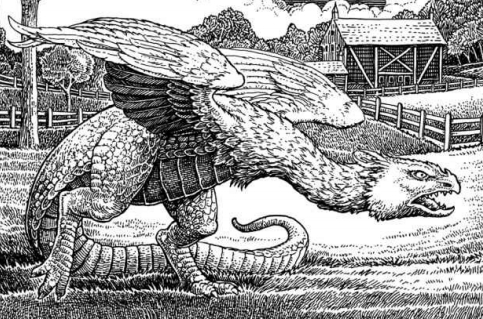
These creatures are rated XXXX by the Ministry of Magic. They aren’t particularly dangerous or deadly, are actually rather docile once you become acquainted with one. So what warrants such a high rating? They have fangs made of serrated steel and a bulletproof hide. As carnivorous creatures, they use their teeth to easily crush their prey. With a bulletproof hide, it becomes incredibly difficult to cast spells on them to control an unruly individual. Like a kappa, it is best to place a harness over their heads, allowing you to magically fasten a rope or lead, and enabling you to take control of the situation.
We will be offering a field trip to Maryland this weekend if you are interested in seeing a Snallygaster in person! Please let myself or Professor Cattercorn know if you are interested in attending, as we do need to have a signed waiver from your parents because of their rating.
The Phoenix: Riser From the Ashes
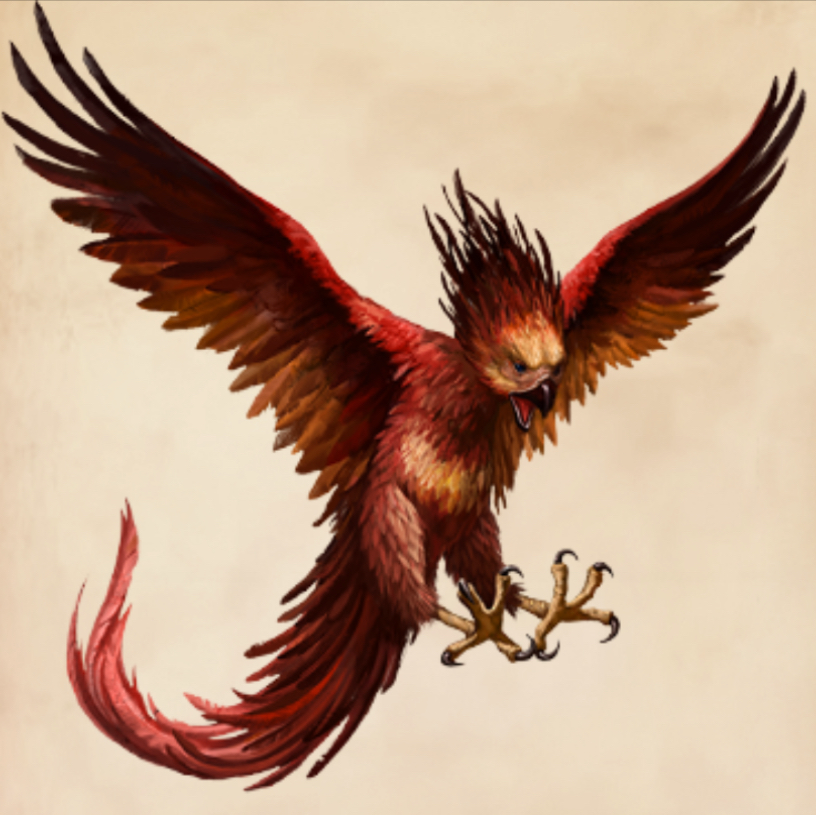 Let’s now move on to the final creature today! The phoenix is a swan-sized bird native to China, Egypt, and India. They are scarlet red and gold in color, with a long, sweeping tail. Their scarlet feathers glow faintly and their gold feathers are hot when you touch them. Their talons and beaks are gold, while their eyes are jet black. This makes for a very stark contrast on their face! They have four talons on each leg. They remind me of a claw in those Muggle children’s games, where you try and grab the prize. Their feet are expertly designed to capture prey, that is for sure!
Let’s now move on to the final creature today! The phoenix is a swan-sized bird native to China, Egypt, and India. They are scarlet red and gold in color, with a long, sweeping tail. Their scarlet feathers glow faintly and their gold feathers are hot when you touch them. Their talons and beaks are gold, while their eyes are jet black. This makes for a very stark contrast on their face! They have four talons on each leg. They remind me of a claw in those Muggle children’s games, where you try and grab the prize. Their feet are expertly designed to capture prey, that is for sure!
Phoenixes are very gentle and kind creatures, but don’t mistake that to mean they are the best pets. They are very free spirited and incredibly hard to domesticate. It is for this reason that they are classified as an XXXX creature. Very few wizards have been able to domesticate them. Three domesticated phoenixes are currently recorded throughout history: Fawkes, the phoenix kept by Albus Dumbledore and used to assist in his communications with the Order of the Phoenix; Sparky, the mascot of the Moutohora Macaws Quidditch team; and Ned, who is currently kept in the Department for the Regulation and Control of Magical Creatures office because he was found by a Muggle who thought he was a parrot and treated him as such. This did cause some emotional scarring for Ned, so rather than uproot him again, the office decided it was best to keep him. He is a really sweet bird. I try to visit him anytime I am at the Ministry. He really enjoys fresh kale. But, I digress.
Diet and Habitat
Phoenixes, while they have wonderful adaptations to capture prey, are actually herbivores. They feed on the vegetation in their nesting area, which is typically near mountain tops. They try not to travel far from their nesting areas, but will do so in times of need or drought. Phoenixes are solitary creatures and do not live in groups. Individuals may live in the same area and cross paths regularly when searching for food, but they have no interactions.
Phoenixes make their nests by weaving sticks together to make incredibly intricate walls. They also use blades of grass or flower petals to add hints of color to their nests. This is how they identify their nests from other phoenixes, as well as mark their territory. Should you find a nest in an undesirable area, it is best to make the nest blend in with its surroundings by using a Disillusionment Charm. While I know you learned about this in Charms last year, I have provided the spell information below to remind you. Now don’t worry, the phoenix will still be able to find their nest. They have a wonderful memory, which allows them to know exactly where their nest is. Once they are on top of it, they are able to see through the charm and see their nest.
Incantation: Talpa (TAWL-puh)
Wand Movement: Depends on the target; Twirl around the body if casting on yourself, a tap on the target if casting on someone or something else.
Willpower: High; Must overcome the will of the target’s cells to remain as is.
Concentration: High; Must visualize the target appearing as their surroundings.
Though they can keep themselves warm in the winter, they do not like to venture out into the cold weather. During the cooler months, phoenixes will keep a stockpile of vegetation in their nests. This is part of why they may travel for vegetation, particularly during the warmer months. This ensures as the weather gets cooler they don’t need to travel as far because they did not deplete the resources closest to them.

Reproduction
The reproduction of a phoenix is incredibly different from that of other birds. The original phoenixes are still alive to this day because they continue to rise up from the ashes. While it is commonly said that a phoenix can live over one thousand years. In actuality, most phoenixes go about one hundred years before their next rebirth.
Burning Day
When a phoenix grows old and starts to resemble a half plucked turkey, that means its “Burning Day” has come. They will look very old and decrepit. When you see this for the first time, it will definitely worry you. Your first experience will stay with you. The first time I saw a Burning Day was when I was seven. I didn’t understand why the bird burst into flames, or why a chick emerged from the ashes. I was worried someone was hurting the bird, and had put a spell on him. Now, while it is rather alarming to see the bird burst into flames, good comes out of it. Out of the ashes emerges a grey chick, ready to grow into itself again. They will only stay a chick for a month before growing into their teenage state. The teenage state lasts anywhere from two to four months. The teenage state is distinguishable from the adult state by the length of the tail feathers. The tail feathers of a teenage phoenix are about one foot long. Anything longer than that is considered an adult phoenix.
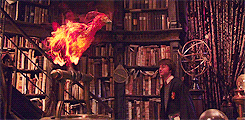
Abilities and Uses
Phoenixes have many unique abilities. Their tears are the only known antidote for basilisk venom and are known for bringing someone back from the brink of death, like unicorn blood. Along with that, they cannot be killed or petrified when faced with a basilisk’s stare. Phoenixes can also take a Killing Curse in stride, however, it will affect their overall physical health. Because they are a rebirthing mortal, meaning they “die” because they are mortal but are reborn from their own ashes, they can receive the full power of a Killing Curse and still experience their rebirth. What other creatures do you know can do that? The phoenix song is also noteworthy, as it touches the soul of whoever hears it. It can touch them in a positive or negative way, like causing fear in those who are evil and courage in those who are truly good. It is important to note that even if two good people hear the same lament it will affect them both differently.
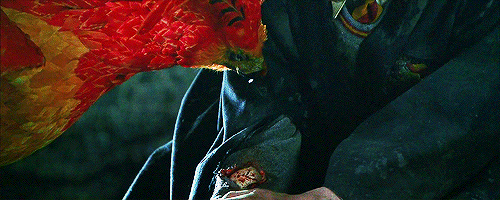
Phoenixes are also able to use a form of Apparition very similar to house-elves. They can disappear and reappear at will, taking humans with them, and are not restricted to the same rules that wizards are. When disappearing, they can opt to leave behind one of their golden tail feathers as a message or symbol. They can also carry extremely heavy loads, meaning they have incredible strength in their leg and wing muscles.
Phoenix feathers are also used for a variety of purposes. They make an excellent wand core, and are considered the most intuitive of all the wand cores. Sometimes wands with a phoenix feather core will act on their own. Having a phoenix feather as a wand core is incredibly rare, as it is hard to gather their feathers.
The transition between the teenage state and the adult state is the best time to collect feathers, should you be out on the mountain tops seeking them. If you run into a domesticated phoenix, you can collect their feathers at any time because of their bond with their owner. The golden feathers of the teenage state are not as hot to the touch as adult feathers, rendering them easier to collect and use as quills.
The best way to use a golden phoenix feather as a quill is to use a Freezing Charm on them. This allows you to comfortably hold the quill without it burning your palm and fingers. Though the golden quills are beautiful, scarlet quills are still more popular in quill and stationery stores. I personally think this is because people are too lazy to regularly cast Freezing Charms on the golden ones. Though, there is also a significant price gouging issue between the two colors, and that also might cause the difference in popularity.
With that, I will turn the lesson back over to Professor Cattercorn for a moment before I discuss the assignments for today.
Closing
Thank you Professor Anne for teaching us about those new, exciting creatures! I hope you all enjoyed this lesson as much as we did. We have been planning this content out for quite some time now. But don’t let this knowledge you gained today leave you so quickly as there is a bit of homework for you all, as usual. Professor Anne will fill you all in on that now, and I will see you again in the next class. Goodbye, everyone!
Alright class, let me fill you in quickly about your assignments for this week. As I mentioned earlier in the lesson, an optional field trip will be available if you’d like to see a Snallygaster in person. I will have a signup sheet available until the end of the week. Remember, we will need a signed form from your parents to take you to another country. There is also an essay for you to complete before your next class. I hope to see you all on the field trip! Until then, have a great week and remember to study for your midterm!
All pictures are found using the Google Images search engine, and belong to their owners.
We will be building off of your prior knowledge of these creatures from popular culture, and helping you understand why they are seen in both worlds. Some of these creatures are considered cryptids or mythological in the Muggle world, whereas others have Muggle counterparts.
- COMC-OWL
Enroll


